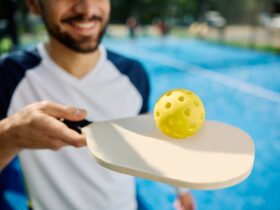Pickleball is a popular sport that has gained tremendous popularity in recent years, attracting players of all age groups and skill levels.
One crucial aspect of pickleball involves choosing the appropriate type of ball for the playing environment, whether indoor or outdoor.
This article will delve into the key differences between indoor and outdoor pickleball balls, providing insights into how each variant impacts playability and performance.
The Core Material
In order to differentiate between indoor and outdoor pickleballs, one must first understand the core material from which they are made.
Generally, both types of balls are crafted from durable plastic materials; however, the specific composition varies significantly, affecting their overall weight and bounce characteristics.
Indoor Pickleball Cores
Typically, indoor pickleballs are designed with a slightly softer plastic material that gives them a lighter feel. The exclusive use of premium-quality polyethylene aids in creating a gentler touch and results in a muted sound during play.
The enhanced softness of indoor pickleballs translates to better control over shots and improved accuracy for players. Moreover, these balls are less prone to bouncing off walls and other indoor structures, making them perfect for gymnasiums and other enclosed spaces.
Outdoor Pickleball Cores
On the other hand, outdoor pickleballs are constructed using a harder material formulation that includes a blend of virgin polyethylene and other additives. This produces a heavier and more robust ball capable of enduring harsh weather conditions and rough surfaces. Furthermore, the increased stiffness of outdoor pickleballs ensures greater resistance to wind, enabling players to execute powerful shots with minimal interference.
Hole Size and Pattern
A major distinction between indoor and outdoor pickleballs lies in their respective hole size and drill pattern. This variance in design is crucial, as it greatly influences the ball’s overall aerodynamics and flight behavior in different settings.
Indoor Pickleball Holes
Indoor pickleballs generally have larger holes compared to their outdoor counterparts, with the average diameter measuring around 0.26 inches. These wider apertures contribute to a slower ball speed which allows for better control during volley exchanges.
Additionally, indoor balls have fewer holes, typically numbering between 26 and 40, arranged in specific patterns to maximize air-flow resistance.
This combination of large holes and reduced count promotes stable flight paths and lessens unpredictable deviations, thereby creating a more enjoyable playing experience indoors.
Outdoor Pickleball Holes
In contrast, outdoor pickleballs are designed with smaller holes, averaging around 0.20 inches in diameter. The primary rationale behind employing narrower openings is to counteract the effects of wind on the ball’s trajectory.
Furthermore, outdoor balls typically feature a higher hole count, ranging from 40 to 68, to minimize air resistance and maintain consistent flight characteristics. These factors combine to ensure outdoor pickleballs travel faster than their indoor counterparts and provide players with greater shot velocity.
Size and Weight Differences
An essential factor governing the choice between indoor and outdoor pickleballs is the variation in size and weight measurements. Since these dimensions have a direct impact on how a ball reacts upon contact with the paddle, understanding the deviation is critical for optimal performance.
Indoor Pickleball Size and Weight
- Weight: Indoor pickleballs usually weigh around 0.81 ounces (23 grams). This lighter mass facilitates enhanced control over shots and improved maneuverability for players.
- Size: Indoor balls feature a diameter of approximately 2.87 inches (73 millimeters). The slightly smaller sizing contributes to reduced bounce and better engagement with the playing surface, which is ideal for indoor play.
Outdoor Pickleball Size and Weight
- Weight: Outdoor pickleballs are typically heavier, weighing around 0.99 ounces (28 grams). This increased mass enables players to generate more force during shots, resulting in higher velocities.
- Size: Outdoor balls possess a larger diameter of about 2.96 inches (75 millimeters). This dimension not only aids in handling wind but also supplies extra stability when connecting with the paddle.
Popular Brands and Models
The market offers an array of indoor and outdoor pickleball options that cater to the diverse preferences of players worldwide. Here are some notable brands and models for each type of ball:
Indoor Pickleballs
- Jugs Sports Indoor Pickleballs
- Onix Fuse Indoor Pickleballs
- PickleballCentral Rally Tyro 2 Pro Indoor Pickleballs
Outdoor Pickleballs
- DURA Fast 40 Outdoor Pickleballs
- Franklin Sports X-40 Performance Outdoor Pickleballs
- TOP Ball Outdoor Pickleballs
Impact of Playing Surfaces
While distinguishing between the properties of indoor and outdoor pickleballs is vital, considering the playing surface is equally important. Indoor courts typically consist of smooth, wooden floors that foster a relatively low bounce and less ball wear. Conversely, outdoor pickleball arenas comprise rough concrete or asphalt surfaces that produce higher bounces and increased wear on the ball.
In conclusion, aspiring pickleball enthusiasts should thoroughly evaluate their specific requirements and conditions before opting for either indoor or outdoor pickleballs. Factors such as core material, hole size and pattern, weight and size differences, and playing surfaces play crucial roles in determining which type of ball would be best-suited for individual needs.







